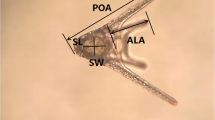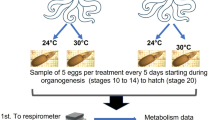Abstract
It is the purpose of this paper to elucidate the possible role of the heat resistance level of mature gametes and embryos of poikilotherms in the adaptation of a species to environmental temperature conditions. Within a species, heat resistance of gametes does not undergo any recognisable changes even in the presence of significant fluctuations in temperature. Evidence in support of this statement was obtained on gametes of invertebrates belonging to different populations of the same species collected in different seasons, and on invertebrates maintained under different temperatures. The heat resistance of gametes is correlated with the degree of thermophily of the species concerned. Species living under similar temperature conditions exhibit minimal, if any, differences in heat resistance. Hence, the heat resistance level of their gametes is a function of temperature conditions of formation and existence of the species as a whole. During the ontogenesis of poikilotherms, eggs, zygotes and early stages of embryonic development are most susceptible to heat injury. The upper thermal limit for the normal development of eggs and embryos is only 1 to 3Co higher than the temperatures encountered under natural conditions. It is concluded that the heat resistance level of gametes and embryos represents an adjustment to temperatures at which spawning, fertilisation and earlier embryonal development occur. Temperatures which, throughout the year, exceed the upper thermal limit or remain below the lower thermal limit for the development of embryos, act as limiting factors for the species' distribution.
Similar content being viewed by others
Literature cited
Alexandrov, V.Y.: The relation between thermostability of protoplasm and environmental temperature conditions. [Russ.] Dokl. Akad. Nauk SSSR 83, 149–152 (1952)
—: On the biological significance of the correlation between the heat resistance level of proteins and the environmental temperature conditions of a species. [Russ.] Usp. sovrem. Biol. 60, 28–44 (1965)
Andronikov, V.B.: Thermostability of the sexual cells and zygotes of sea urchins. [Russ.] Citologija 5, 234–237 (1963)
—: Heat resistance of sexual cells and embryos of poikilothermic animals. [Russ., Summary in English] In: Heat resistance of cells of animals, pp 125–139. Ed. by B.P. Ushakov. Moscow-Leningrad: Academy of Sciences 1965
—: Heat resistance of gametes of poikilothermic animals. In: The cell and environmental temperature, pp 398–402. Ed. by A.S. Troshin. Oxford: Pergamon Press 1967a
—: The character of changes in thermostability of embryos of poikilotherms at early stages of ontogenesis. [Russ., Summary in English] In: Variability in cellular heat resistance of animals in ontogenesis and phylogenesis, pp 4–12. Ed. by B.P. Ushakov. Leningrad: Academy of Sciences 1967b
Appellöf, A.: Über die Beziehungen zwischen Fortpflanzung und Verbreitung mariner Tierformen. Int. Congr. Zool. (8, Graz, 1910), pp 303–311. Jena: 1912
Bhaud, M.: Quelques données sur le déterminisme écologique de la reproduction des annélides polychètes. Mar. Biol. 17, 115–136 (1972)
Bowler, K.: A study of the factors involved in acclimatization to temperature and death at high temperatures in Astacus pallipes. I. Experiments on intact animals. J. cell. comp. Physiol. 63, 119–132 (1963a)
—: A study of the factors involved in acclimatization to temperature and death at high temperatures in Astacus pallipes. II. Experiments at the tissue level. J. cell. comp. Physiol. 63, 133–146 (1963b)
Brett, J.R.: Temperature: animals-fishes; functional responses. In: Marine ecology. Vol. I. Environmental factors, Pt 1. pp 515–560. Ed. by O. Kinne. London: Wiley Interscience 1970
Buzhinskaya, G.N.: A contribution to the ecology of reproduction of Polychaeta in the Posjet Bay (Sea of Japan). [Russ.] Zool. Zh. 52, 1777–1782 (1973)
Calabrese, A.: Individual and combined effects of salinity and temperature on embryos and larvae of the coot clam, Mulinia lateralis (Say). Biol. Bull. mar. biol. Lab., Woods Hole 137, 417–428 (1969)
Davis, H.C. and A. Calabrese: Combined effect of temperature and salinity on development of eggs and growth of larvae of Mercenaria mercenaria and Crassostrea virginica. Fishery Bull. Fish. Wildl. Serv. U.S. 63, 643–655 (1964)
Dregolskaya, I.N.: Heat resistance of ciliated epithelium of gills of Mytilus galloprovincialis L. from the Black Sea. [Russ., Summary in English]. In: Problems of cytoecology of animals, pp 43–50. Ed. by B.P. Ushakov. Moscow: Academy of Sciences 1963
Dzhamusova, T.A.: Thermostability of sea mollusc muscle tissue. [Russ.] Citologija 2, 274–286 (1960)
Ekman, S.: Zoogeography of the sea, 417 pp. London: Sidgwick & Jackson 1953
Giese, G.C.: Comparative physiology: annual reproductive cycles of marine invertebrates. A. Rev. Physiol. 21, 547–576 (1959)
Golikov, A.N.: Species and speciation in poikilothermal animals. Mar. Biol. 21, 257–268 (1973)
— and O.G. Kussakin: Fauna and ecology of gastropod molluscs (Gastropoda, Prosobranchia) of the littoral of the Kuril Islands. [Russ.] Issled. dal'nevost. More i SSSR (Leningrad) 8, 248–346 (1962)
— and O.A. Scarlato: Method for indirectly defining optimum temperatures of inhabitancy for marine cold-blooded animals. Mar. Biol. 20, 1–5 (1973)
Gorodilov, Y.N.: The study of sensitivity of fishes to high temperatures during embryogenesis. I. Changes in the sensitivity of developing eggs of autumn-spawning fish species to the action of high temperature. [Russ.] Citologija 11, 169–179 (1969)
Gunter, G.: Temperature. In: Treatise on marine ecology and paleoecology. Vol. I. Ecology, pp 159–184. Ed. by J.W. Hedgpeth. New York: Geological Society of America 1957. (Mem. geol. Soc. Am. No. 67)
Heinonen, A.: Reproduction of Mytilus edulis (L) in the Finnish southwestern archipelago in summer 1960. Suomal. eläin-ja kasvit. Seur. van. Tiedon. Pöytäk. 16, 137–142 (1961)
Kinne, O.: The effects of temperature and salinity on marine and brackish water animals. I. Temperature. Oceanogr. mar. Biol. A. Rev. 1, 301–340 (1963)
—: Temperature: animals-invertebrates. In: Marine ecology, Vol. I. Environmental factors, Pt 1. pp 407–514. Ed. by O. Kinne. London: Wiley Interscience 1970
Korringa, P.: Water temperature and breeding throughout the geographical range of Ostrea edulis. Année biol. (sér. III) 33, 1–17 (1957)
Largen, M.J.: The influence of water temperature upon the life of the dog whelk Thais lapillus (Gastropoda: Prosobranchia). J. Anim. Ecol. 36, 207–215 (1967)
Lønning, S.: Variations in the thermal sensitivity during the early development of the sea urchin embryo. Ark. Zool. 12, 359–381 (1959)
Loosanoff, V.: Spawning of Venus mercenaria (L). Ecology 18, 506–515 (1937)
Mileikovsky, S.A.: On the relation between thermal limits of spawning and zoogeography of species of marine invertebrates. [Russ.] Zool. Zh. 39, 666–669 (1960)
—: Reproduction and spawning in marine shelf benthic invertebrates and the water temperature. [Russ.] Trudÿ Inst. Okeanol. 88, 113–149 (1970)
Moore, A.R.: Some effect of temperature on development in the sea urchin Allocentrotus fragilis. Biol. Bull. mar. biol. Lab., Woods Hole 117, 150–153 (1959)
Moore, J.A.: Temperature tolerance and rates of development in the eggs of Amphibia. Ecology 20, 459–478 (1939)
—: The role of temperature in speciation of frogs. Biol. Symp. 6, 189–213 (1942)
Orton, J.H.: Sea temperature, breeding and distribution in marine animals. J. mar. biol. Ass. U.K. 12, 339–366 (1920)
Ropes, J.W.: Reproductive cycle of the surf clam Spisula solidissima in offshore New Jersey. Biol. Bull. mar. biol. Lab., Woods Hole 135, 349–365 (1968)
Runnström, S.: Über die Thermopathie der Fortpflanzung und Entwicklung mariner Tiere in Beziehung zu ihrer geographischen Verbreitung Bergens Mus. Årb. 2, 1–67 (1927)
—: Weitere Studien über die Temperaturanpassung der Fortpflanzung und Entwicklung mariner Tiere. Bergens Mus. Årb. (naturvid.) 1929 (10), 1–46 (1929)
—: Die Anpassung der Fortpflanzung und Entwicklung mariner Tiere an die Temperaturverhältnisse verschiedener Verbreitungsgebiete. Bergens Mus. Årb. 1936 (3), 3–36 (1936)
Schlieper, C.: Genotypische und phaenotypische Temperature- und Salzgehaltsadaptionen bei marinen Bodeninvertebraten der Nord- und Ostsee. Kieler Meeresforsch. 16, 180–185 (1960)
Sveshnikov, V.A.: Types of reproduction and development of polychaetes and their geographical distribution. [Russ.] Zool. Zh. 38, 829–841 (1959)
Svinkin, V.B.: Heat resistance of spermatozoa of the grass frog and the lake frog. [Russ.] Citologija 1, 580–586 (1959)
—: Heat resistance of spermatozoa of some Unio species. [Russ.] Dokl. Akad. Nauk SSSR 139, 1227–1230 (1961)
Thompson, T.E.: The influence of temperature on spawning in Adalaria proxima (A. & N.) (Gastropoda, Nudibranchia). Oikos 9, 246–252 (1958)
Thorson, G.: The larval development, growth and metabolism of arctic marine bottom invertebrates compared with those of other seas. Meddr. Grønland 100, 5–155 (1936)
—: Reproductive and larval ecology of marine bottom invertebrates. Biol. Rev. 25, 1–45 (1950)
Ushakov, B.P.: Heat resistance of somatic muscles of amphibians as related to the environmental conditions of a species. [Russ.] Zool. Zh. 34, 578–588 (1955)
—: Heat resistance of cellular proteins of poikilotherms as related to the adaptation of a species to environmental temperature conditions. [Russ.] Zh. obshch. Biol. 17, 154–160 (1956)
—: On the conservatism of the protoplasm of a species in poikilotherms. [Russ.] Zool. Zh. 37, 693–706 (1958a)
—: The problem of tissue and substantial adaptation of poikilotherms to the environmental temperature conditions of existence of a species. In: The evolution of functions of nervous system, pp 57–66. Ed. by D.A. Biryukov. Leningrad: Publishing House of Medical Literature 1958b
—: Heat resistance of different tissues of the frog as related to environmental temperature. In: Problems of cytology and protozoology, pp 84–99. Ed. by Y.I. Polyansky. Moscow-Leningrad: Academy of Sciences 1960a
—: Eine zytophysiologische Analyse der Anpassung der Reptilien an das Leben in der Wüste Karakum. Zool. Jb. 87, 507–524 (1960b)
—: Thermostability of cells and proteins of poikilotherms and its significance in speciation. Physiol. Rev. 44, 518–560 (1964)
—: The present-day state of the problem of heat injury mechanism and causes of changes in cell thermostability. [Russ.] In: Heat resistance of cells of animals, pp 5–52. Ed. by B.P. Ushakov. Moscow-Leningrad: Academy of Sciences 1965
Valli, G.: Cyclo di maturitá sessuale in Mytilus galloprovincialis Lam. di Duino (Trieste). Boll. Pesca Piscic. Idrobiol. 26, 259–265 (1972)
Vernberg, F.J., C. Schlieper and D.E. Schneider: The influence of temperature and salinity on ciliary activity of excised gill tissue of molluscs from North Carolina. Comp. Biochem. Physiol. 8, 271–285 (1963)
Volpe, E.P.: Embryonic temperature adaptations and relationships in toads. Physiol. Zoöl. 26, 344–354 (1953)
Zakhvatkina, K.A.: Phenology of larvae of bivalves of Sevastopol Bay. [Russ.] Trudÿ sevastopol. biol. Sta. 16, 173–176 (1963)
Zhirmunsky, A.V.: A study of temperature adaptation of invertebrates from the South China Sea. [Russ.] Citologija 2, 675–691 (1960)
—: A comparative study of cellular thermostability of marine invertebrates in relation to their geographical distribution and ecology. In: The cell and environmental temperature, pp 142–150. Ed. by B.P. Ushakov. Moscow-Leningrad: Academy of Sciences 1964
—: Cellular thermostability of marine invertebrates in relation to vertical distribution of the species in the upper sublittoral of Possiet Bay (Japan Sea). In: Scientific papers of the Institute of Marine Biology, pp 65–67. Ed. by A.V. Zhirmunsky. Vladivostock: Academy of Sciences of the USSR, Far Eastern Scientific Center 1969
— and Tsu-Li-Tsun: The heat resistance of the ciliated epithelium of sympatric species of tropical molluscs of the Nerita species as related to the environmental temperature conditions. [Russ.] Citologija 2, 478–482 (1960)
Author information
Authors and Affiliations
Additional information
Communicated by M.E. Vinogradov, Moscow
Rights and permissions
About this article
Cite this article
Andronikov, V.B. Heat resistance of gametes of marine invertebrates in relation to temperature conditions under which the species exist. Mar. Biol. 30, 1–11 (1975). https://doi.org/10.1007/BF00393747
Accepted:
Issue Date:
DOI: https://doi.org/10.1007/BF00393747




